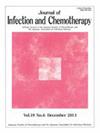在日本一家资源有限的小型医院,药剂师主导的逐步抗菌药物管理计划对静脉注射抗菌药物使用的纵向影响
IF 1.9
4区 医学
Q3 INFECTIOUS DISEASES
引用次数: 0
摘要
临床药师在抗菌药物管理计划(ASP)的实施中发挥着核心作用。然而,人员短缺、缺乏职业发展体系等挑战阻碍了日本临床药师对asp的积极贡献。目的对药剂师主导的抗菌药物管理项目进行长期评估。方法回顾性研究采用分段时间序列分析方法,对抗菌药物的使用情况、血培养情况和病原菌对抗菌药物的耐药率进行调查。结果:ASP引入后,抗假单胞菌药物的治疗天数(DOT)呈下降趋势(- 0.31;95%置信区间[CI]:−0.43 ~−0.19;p & lt;0.01)。此外,干预后血培养次数趋势显著增加(0.20;95% CI: 0.05 ~ 0.35;p = 0.01),铜绿假单胞菌对头孢吡肟和哌拉西林的耐药率下降。干预前后静脉总抗菌药物使用的DOT趋势无显著变化(- 1.07;95% CI:−2.44 ~ 0.29;p = 0.12)。结论:虽然药剂师在ASP中的作用有待进一步研究,但目前的纵向研究发现,逐步引入ASP减少了广谱抗菌药物的使用,并与铜绿假单胞菌的耐药率下降有关,但与第三代耐头孢菌素大肠杆菌或MRSA的耐药率下降无关。本文章由计算机程序翻译,如有差异,请以英文原文为准。
Longitudinal impact of a pharmacist-led stepwise antimicrobial stewardship program on intravenous antimicrobial use at a small resource-limited Japanese hospital
Background
Clinical pharmacists play a central role in the implementation of antimicrobial stewardship programs (ASP). However, personnel shortages, the lack of a system for career development, and other challenges impede the active contribution of clinical pharmacists to ASPs in Japan.
Aim
To conduct a long-term evaluation of a pharmacist-led antimicrobial stewardship program.
Methods
The present, retrospective study used segmented time-series analysis to examine antimicrobial consumption, blood culture practices, and the rate of resistance in pathogens to the antimicrobials prescribed.
Findings
After the ASP was introduced, days of therapy (DOT) with anti-pseudomonal agents demonstrated a downward trend (−0.31; 95 % confidence interval [CI]: −0.43 to −0.19; p < 0.01). Moreover, the trend in the number of blood cultures after the intervention significantly increased (0.20; 95 % CI: 0.05 to 0.35; p = 0.01), and the rate of resistance of Pseudomonas aeruginosa to cefepime and piperacillin decreased. No significant change was observed in the DOT trend for total intravenous antimicrobial use before or after the intervention (−1.07; 95 % CI: −2.44 to 0.29; p = 0.12).
Conclusion
Although the role of pharmacists in an ASP should continue to be examined, the present, longitudinal study found that stepwise introduction of an ASP reduced broad-spectrum antimicrobial use and was associated with a decrease in the antimicrobial resistance rate of Pseudomonas aeruginosa but not of third-generation cephalosporin-resistant Escherichia coli or MRSA.
求助全文
通过发布文献求助,成功后即可免费获取论文全文。
去求助
来源期刊

Journal of Infection and Chemotherapy
INFECTIOUS DISEASES-PHARMACOLOGY & PHARMACY
CiteScore
4.10
自引率
4.50%
发文量
303
审稿时长
47 days
期刊介绍:
The Journal of Infection and Chemotherapy (JIC) — official journal of the Japanese Society of Chemotherapy and The Japanese Association for Infectious Diseases — welcomes original papers, laboratory or clinical, as well as case reports, notes, committee reports, surveillance and guidelines from all parts of the world on all aspects of chemotherapy, covering the pathogenesis, diagnosis, treatment, and control of infection, including treatment with anticancer drugs. Experimental studies on animal models and pharmacokinetics, and reports on epidemiology and clinical trials are particularly welcome.
 求助内容:
求助内容: 应助结果提醒方式:
应助结果提醒方式:


